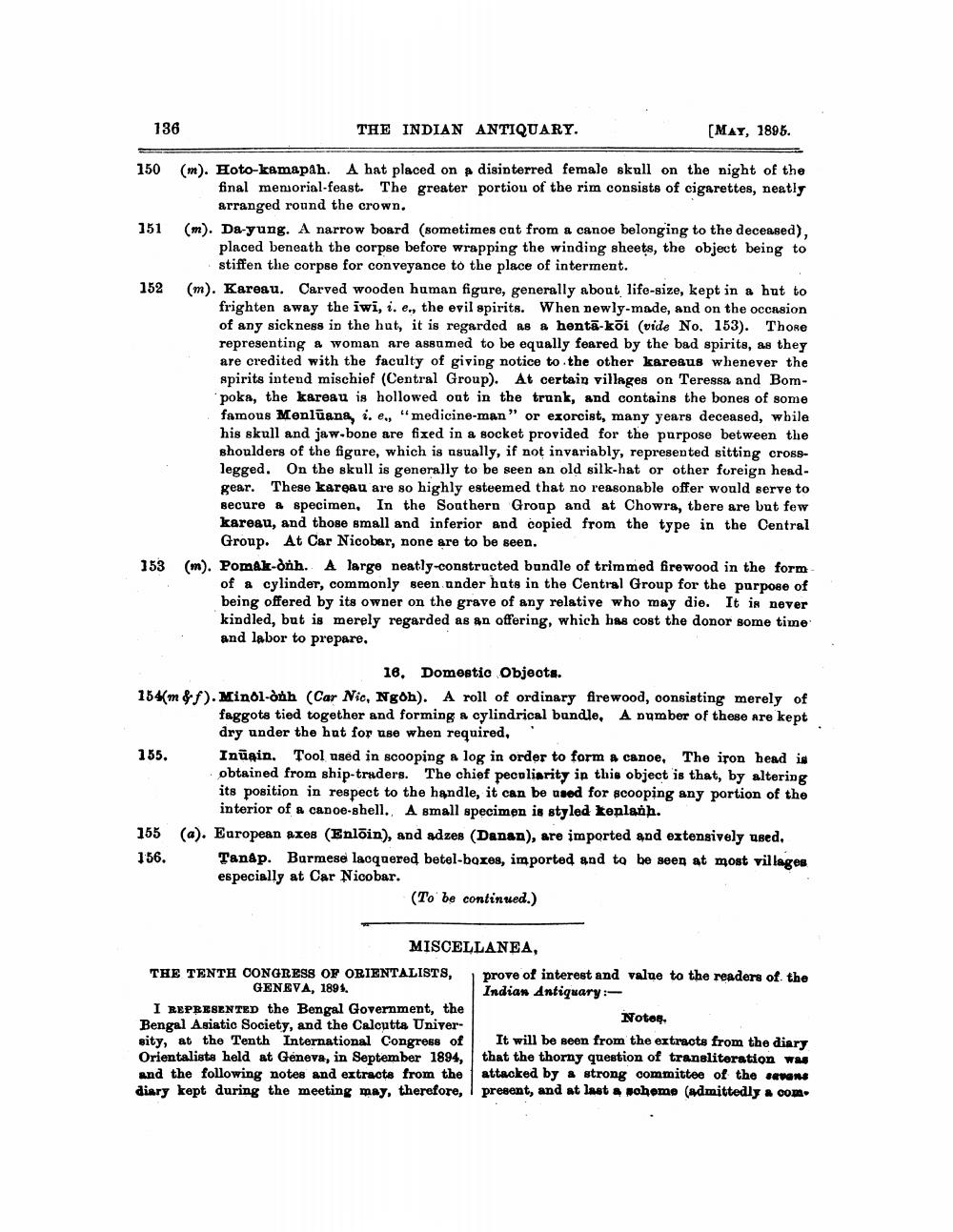________________
136
THE INDIAN ANTIQUARY.
(MAY, 1895.
150
151
152
(m). Hoto-kamapah. A hat placed on a disinterred female skull on the night of the
final memorial-feast. The greater portiou of the rim consists of cigarettes, neatly
arranged round the crown. (m). Da-yung. A narrow board (sometimes cat from a canoe belonging to the deceased).
placed beneath the corpse before wrapping the winding sheets, the object being to
stiffen the corpse for conveyance to the place of interment. (m). Kareau. Carved wooden human figure, generally about life-size, kept in a hat to
frighten away the iwi, i. e., the evil spirits. When newly-made, and on the occasion of any sickness in the hut, it is regarded as a hentā-kõi (vide No. 153). Thore representing a woman are assumed to be equally feared by the bad spirits, as they are credited with the faculty of giving notice to the other kare&us whenever the spirits intend mischief (Central Group). At certain villages on Teressa and Bompoka, the kareau is hollowed out in the trunk, and contains the bones of some famous Menlūang, i. e., "medicine-man" or exorcist, many years deceased, wbile his skull and jaw.bone are fixed in a socket provided for the purpose between the shoulders of the figure, which is usually, if not invariably, represented sitting crosslegged. On the skull is generally to be seen an old silk-hat or other foreign headgear. These kareau are so highly esteemed that no reasonable offer would serve to Becure & specimen. In the Southern Group and at Chowra, tbere are but few kareau, and those small and inferior and copied from the type in the Central
Group. At Car Nicobar, none are to be seen. (m). Pomak-onh. A large neatly-constructed bundle of trimmed firewood in the form
of a cylinder, commonly seen ander hats in the Central Group for the purpose of being offered by its owner on the grave of any relative who may die. It is never kindled, but is merely regarded as an offering, which has cost the donor some time and labor to prepare,
153
18. Domestic Objecta. 154(m&f). Minol-onh (Car Nic, Ngôh). A roll of ordinary firewood, consisting merely of
faggots tied together and forming a cylindrical bundle, A pumber of these are kept
dry under the hat for use when required, 155. Inūgin. Tool used in scooping a log in order to form a canoe, The iron head is
obtained from ship-traders. The chief pecoliarity in this object is that, by altering its position in respect to the handle, it can be used for scooping any portion of the
interior of a canoe-shell. A small specimen is styled Leplanh. 155 (a). European axes (Enlõin), and adzes (Danan), are imported and extensively used, 156. Tanap. Burmese lacquered betel-boxes, imported and to be seen at most villages especially at Car Nicobar.
(To be continued.)
MISCELLANEA, THE TENTH CONGRESS OF ORIENTALISTS, prove of interest and value to the readers of the GENEVA, 1891.
Indian Antiquary:I REPRESENTED the Bengal Government, the
Notes. Bengal Asiatic Society, and the Calcutta University, at the Tenth International Congress of It will be seen from the extracts from the diary Orientalists held at Geneva, in September 1894, that the thorny question of transliteration was and the following notes and extracts from the attacked by a strong committee of the sevans diary kept during the meeting may, therefore, present, and at last & pohome (admittedly a com




